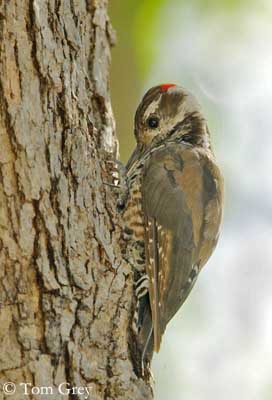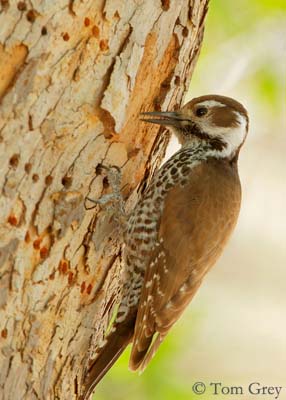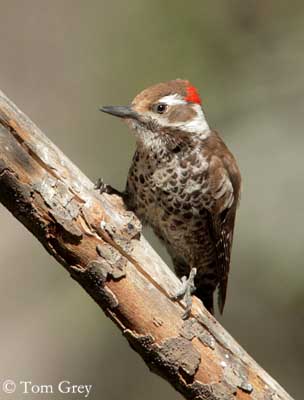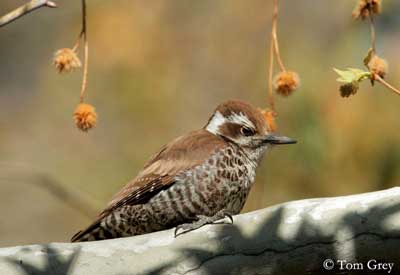
Arizona Woodpecker
Picoides arizonae
Piciforme Order – Picidae Family
BIOMETRICS:
Length: 18-20 cm
Wingspan: 36 cm
Weight: 34-50 g
DESCRIPTION:
Arizona Woodpecker is mainly known as subspecies of Strickland’s Woodpecker (Picoides stricklandi), but the latter is now split into two distinct species. The northern birds from Arizona are named Arizona Woodpecker, and the southern populations of central Mexico are named Strickland’s Woodpecker.
Both species are very similar. It is the only brown and white woodpecker instead black and white like almost all the others.
The species displayed here is the Arizona Woodpecker.
PROTECTION / THREATS / STATUS:
Arizona Woodpecker has very limited range and it is usually uncommon, depending on forest, but sometimes, it may be locally common.
The species may be threatened by fragmentation and habitat loss.
Fr: Pic d’Arizona
Esp: Carpintero de Arizona
Photographs by Tom Grey
Tom Grey's Bird Pictures
Text by Nicole Bouglouan
Sources :
HANDBOOK OF THE BIRDS OF THE WORLD Vol. 7 by Josep del Hoyo-Andrew Elliott-Jordi Sargatal – Lynx Edicions – ISBN: 8487334377
WOODPECKERS, an identification guide of the woodpeckers of the world by Winkler Hans and Christie David – Helm – ISBN: 0395720435
A GUIDE TO THE BIRDS OF MEXICO AND NORTHERN CENTRAL AMERICA by Steve N. G. Howell, Sophie Webb - Oxford University Press - ISBN: 0198540124
The Birds of North America online
What Bird-The ultimate Bird Guide (Mitchell Waite)
Wikipedia (Wikipedia, The Free Encyclopedia)

Adult male has brown plumage overall. Upperparts are brown with indistinct white wing bars, and sparsely spotted white primaries. Rump is darker. The tail is blackish with barred white outer feathers.
On the underparts, chin and throat are whitish. Rest of underparts is whitish heavily spotted dark brown, giving scaled pattern. Flanks are rather barred than spotted.
On the head, male has dark brown crown and nape, with red patch on the hindcrown. Face is white with dark brown ear-coverts, malar stripe and upper lores.
The straight, chisel-tipped bill is blackish. Eyes are dark brown. Legs and feet are greyish.
Female has similar appearance but she lacks the red patch on the nape which is dark brown.
The juvenile is duller than adults, darker on the underparts with heavier markings. Young male and female have orange-red on crown, only on hindcrown in female.
VOICE: SOUNDS BY XENO-CANTO
Arizona Woodpecker utters sharp, slightly shrill “chik” or “peek”, also a nasal “chriek’a” repeated 2-5 times, and a rapid, screeching chatter.
HABITAT:
Arizona Woodpecker frequents arid to semi-humid pine-oak woodlands and riparian wooded areas with sycamore and walnut in canyons.
It is visible up to 1200-2400 metres of elevation.
RANGE:
Arizona Woodpecker is found in extreme SW New Mexico and SE Arizona. The species extends southwards into Mexico through Sierra Madre Occidental.

BEHAVIOUR:
Arizona Woodpecker feeds on beetles and larvae, other insects, some fruits, acorns and seeds.
It moves rapidly up to trunk and branches, and then, moves to another tree. It may forage on the ground, coming from middle level in tree to lower area. It usually forages alone, but may join mixed-species foraging groups.
The most common feeding behaviour consists in excavating or removing bark, and then, probing, gleaning and flycatching on exposed invertebrates.
Arizona Woodpecker is territorial at nest-site, being aggressive towards the intruders. Usually, each bird engages intruder of the same sex, while the mate observes but does not take part in conflict.
The male performs courtship displays at the beginning of the breeding season. It flies in flutter-aerial display with wings held while the bird glides towards the female at nest-site. It also drums and does signal-tapping near the cavity.

Arizona Woodpecker is resident in the range. Some altitudinal movements are recorded in SE Arizona, probably according to the food resources.
FLIGHT:
Arizona Woodpecker performs rapid wing beats interspersed with glides, involving the typical undulating flight of woodpeckers.
REPRODUCTION:
Breeding season occurs in April-May.
The nest is a hole excavated in tree trunk, in dead part of evergreen oaks, sycamores, riparian walnuts, and also in agave stems, between 2, 50 and 14 metres above the ground.
The cavity is about 30-38 cm in depth and unlined. Both sexes excavate the hole, but mainly the male.
Female lays 2-4 white eggs. Incubation by both sexes lasts about two weeks.
The altricial chicks are brooded and fed by both parents. The nesting period lasts about 24 to 27 days, ending when the juveniles are full feathered. There are still fed by parents and follow the adults during some weeks.
DIET:
Arizona Woodpecker feeds on insects, mainly beetles and larvae, fruits, acorns and seeds.
